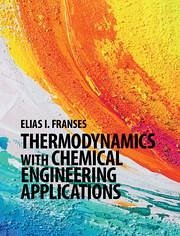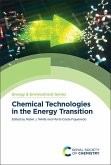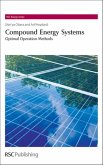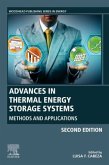Elias I Franses
Thermodynamics with Chemical Engineering Applications
Elias I Franses
Thermodynamics with Chemical Engineering Applications
- Gebundenes Buch
- Merkliste
- Auf die Merkliste
- Bewerten Bewerten
- Teilen
- Produkt teilen
- Produkterinnerung
- Produkterinnerung
Master the principles of thermodynamics, and understand their practical real-world applications, with this deep and intuitive undergraduate textbook.
Andere Kunden interessierten sich auch für
![Chemical Technologies in the Energy Transition Chemical Technologies in the Energy Transition]() Chemical Technologies in the Energy Transition195,99 €
Chemical Technologies in the Energy Transition195,99 €![Compound Energy Systems Compound Energy Systems]() Shin'ya ObaraCompound Energy Systems152,99 €
Shin'ya ObaraCompound Energy Systems152,99 €![Green Chemical Engineering Green Chemical Engineering]() S. SureshGreen Chemical Engineering186,99 €
S. SureshGreen Chemical Engineering186,99 €![Advances in Thermal Energy Storage Systems Advances in Thermal Energy Storage Systems]() Advances in Thermal Energy Storage Systems202,99 €
Advances in Thermal Energy Storage Systems202,99 €![Fuel Cells Fuel Cells]() Noriko Hikosaka BehlingFuel Cells222,99 €
Noriko Hikosaka BehlingFuel Cells222,99 €![Hydrogen Storage Materials Hydrogen Storage Materials]() Hydrogen Storage Materials201,99 €
Hydrogen Storage Materials201,99 €![Handbook of Nuclear Engineering Handbook of Nuclear Engineering]() Dan Gabriel Cacuci (ed.)Handbook of Nuclear Engineering2.018,99 €
Dan Gabriel Cacuci (ed.)Handbook of Nuclear Engineering2.018,99 €-
-
-
Master the principles of thermodynamics, and understand their practical real-world applications, with this deep and intuitive undergraduate textbook.
Produktdetails
- Produktdetails
- Verlag: Cambridge University Press
- Seitenzahl: 466
- Erscheinungstermin: 25. August 2014
- Englisch
- Abmessung: 254mm x 195mm x 27mm
- Gewicht: 1203g
- ISBN-13: 9781107069756
- ISBN-10: 1107069750
- Artikelnr.: 41313869
- Herstellerkennzeichnung
- Libri GmbH
- Europaallee 1
- 36244 Bad Hersfeld
- gpsr@libri.de
- Verlag: Cambridge University Press
- Seitenzahl: 466
- Erscheinungstermin: 25. August 2014
- Englisch
- Abmessung: 254mm x 195mm x 27mm
- Gewicht: 1203g
- ISBN-13: 9781107069756
- ISBN-10: 1107069750
- Artikelnr.: 41313869
- Herstellerkennzeichnung
- Libri GmbH
- Europaallee 1
- 36244 Bad Hersfeld
- gpsr@libri.de
Elias I. Franses has been a Professor of Chemical Engineering at Purdue University for over 30 years. An expert in thermodynamics, he has taught numerous courses on this topic to chemical engineering students of all levels.
1. Introduction and synopsis; 2. Problems and concepts at the interface of mechanics and thermodynamics; 3. Phases
interfaces
dispersions
and the first three principles of thermodynamics; 4. Internal energy
the First Law
heat
conservation of total energy; 5. Equations of state for one-component and multicomponent systems; 6. Applications of the mass and energy balances and the equations of state to several classes of thermodynamic problems; 7. The Second Law
absolute temperature
entropy definition and calculation
and entropy inequality; 8. Further implications of the Second Law. Introduction of Helmholtz free energy
Gibbs free energy
chemical potential
and applications to phase equilibria
heat transfer and mass transfer; 9. Thermodynamic fugacity
thermodynamic activity
and other thermodynamic functions (U
H
S
A
G
¿i) of ideal and nonideal solutions; 10. Vapor-liquid equilibria (VLE) with applications to distillation; 11. Gas-liquid equilibria (GLE) and applications to gas absorption or desorption; 12. Applications to liquid-liquid equilibria and liquid-liquid extraction; 13. Osmosis
osmotic pressure
osmotic equilibrium
and reverse osmosis; 14. Third Law and molecular basis of the Second and Third Laws; 15. Some special implications and applications of the First and Second Laws; 16. Chemical reaction equilibria: one reaction; 17. Chemical reaction equilibria: two or more reactions occurring simultaneously; 18. Applications of thermodynamics to energy engineering and environmental engineering.
interfaces
dispersions
and the first three principles of thermodynamics; 4. Internal energy
the First Law
heat
conservation of total energy; 5. Equations of state for one-component and multicomponent systems; 6. Applications of the mass and energy balances and the equations of state to several classes of thermodynamic problems; 7. The Second Law
absolute temperature
entropy definition and calculation
and entropy inequality; 8. Further implications of the Second Law. Introduction of Helmholtz free energy
Gibbs free energy
chemical potential
and applications to phase equilibria
heat transfer and mass transfer; 9. Thermodynamic fugacity
thermodynamic activity
and other thermodynamic functions (U
H
S
A
G
¿i) of ideal and nonideal solutions; 10. Vapor-liquid equilibria (VLE) with applications to distillation; 11. Gas-liquid equilibria (GLE) and applications to gas absorption or desorption; 12. Applications to liquid-liquid equilibria and liquid-liquid extraction; 13. Osmosis
osmotic pressure
osmotic equilibrium
and reverse osmosis; 14. Third Law and molecular basis of the Second and Third Laws; 15. Some special implications and applications of the First and Second Laws; 16. Chemical reaction equilibria: one reaction; 17. Chemical reaction equilibria: two or more reactions occurring simultaneously; 18. Applications of thermodynamics to energy engineering and environmental engineering.
1. Introduction and synopsis; 2. Problems and concepts at the interface of mechanics and thermodynamics; 3. Phases
interfaces
dispersions
and the first three principles of thermodynamics; 4. Internal energy
the First Law
heat
conservation of total energy; 5. Equations of state for one-component and multicomponent systems; 6. Applications of the mass and energy balances and the equations of state to several classes of thermodynamic problems; 7. The Second Law
absolute temperature
entropy definition and calculation
and entropy inequality; 8. Further implications of the Second Law. Introduction of Helmholtz free energy
Gibbs free energy
chemical potential
and applications to phase equilibria
heat transfer and mass transfer; 9. Thermodynamic fugacity
thermodynamic activity
and other thermodynamic functions (U
H
S
A
G
¿i) of ideal and nonideal solutions; 10. Vapor-liquid equilibria (VLE) with applications to distillation; 11. Gas-liquid equilibria (GLE) and applications to gas absorption or desorption; 12. Applications to liquid-liquid equilibria and liquid-liquid extraction; 13. Osmosis
osmotic pressure
osmotic equilibrium
and reverse osmosis; 14. Third Law and molecular basis of the Second and Third Laws; 15. Some special implications and applications of the First and Second Laws; 16. Chemical reaction equilibria: one reaction; 17. Chemical reaction equilibria: two or more reactions occurring simultaneously; 18. Applications of thermodynamics to energy engineering and environmental engineering.
interfaces
dispersions
and the first three principles of thermodynamics; 4. Internal energy
the First Law
heat
conservation of total energy; 5. Equations of state for one-component and multicomponent systems; 6. Applications of the mass and energy balances and the equations of state to several classes of thermodynamic problems; 7. The Second Law
absolute temperature
entropy definition and calculation
and entropy inequality; 8. Further implications of the Second Law. Introduction of Helmholtz free energy
Gibbs free energy
chemical potential
and applications to phase equilibria
heat transfer and mass transfer; 9. Thermodynamic fugacity
thermodynamic activity
and other thermodynamic functions (U
H
S
A
G
¿i) of ideal and nonideal solutions; 10. Vapor-liquid equilibria (VLE) with applications to distillation; 11. Gas-liquid equilibria (GLE) and applications to gas absorption or desorption; 12. Applications to liquid-liquid equilibria and liquid-liquid extraction; 13. Osmosis
osmotic pressure
osmotic equilibrium
and reverse osmosis; 14. Third Law and molecular basis of the Second and Third Laws; 15. Some special implications and applications of the First and Second Laws; 16. Chemical reaction equilibria: one reaction; 17. Chemical reaction equilibria: two or more reactions occurring simultaneously; 18. Applications of thermodynamics to energy engineering and environmental engineering.








